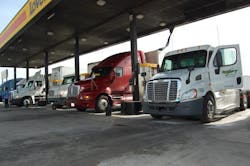This report – developed by the PIRA Energy Group for the Fuels Institute, with funding support from the NATSO Foundation, the research subsidiary of the truck stop trade group NATSO, Inc. – aimed to divine whether adequate supplies of diesel fuel would be available in the U.S. over the course of the next 15 years or so.
In sum, some good things are in the offing, at least according to this analysis. For starters, U.S. consumption of diesel is expected to start dropping in 2016 – even as worldwide consumption increases – as more heavy trucks are expected to switch over to natural gas, among other developments.
Now, a lot of truckers might be saying, “Switch to natural gas? Are you crazy? Look how low the price of diesel is getting.” Indeed, some experts figure that the steady decline of diesel prices will retard such conversions down the road with some truck OEMs are even putting their natural gas development plans on hold as a result.Yet John Eichberger (at left), executive director of the Fuels Institute, cautioned trucking fleets in particular that making long-term strategic decisions based on short-term pricing data isn’t a good idea.
“The extraction process that’s come online in recent years – fracking – is not going away and is making prices for natural gas and oil far more stable, especially domestically,” he explained to me by phone.
“Back in 2007, we were worried about the energy security implications of importing more oil. Since then everything’s completely changed as technology [fracking] has stepped up,” Eichberger said. “We’ve got a lot more domestic supply and [energy] pricing is far more stable. For the consumer and for the overall U.S. economy, that stability is key.”
PIRA’s research indicates that an increase in overall vehicle efficiencies alongside growing use of compressed natural gas (CNG) for heavy-duty vehicles will more than offset a substantial increase in the number of diesel-powered light-duty vehicles entering the U.S. market over the next 15 years – leading to a decline in U.S. diesel demand beginning in 2016.The group said U.S. diesel fuel demand is expected to drop 12.5% from a near-term peak of roughly 4 million barrels per day (MMB/D) in 2015 to 3.5 MMB/D in 2030 and while domestic demand for diesel fuel is expected to peak in 2015, global demand for diesel fuel is expected to increase by more than 6 MMB/D from 2013 to 2030, driven by industrialization in emerging markets as well as by increased use of diesel in global shipping fuels.
“Light-duty diesel sales are expected to increase 300% actually, but that increase is starting from a very small number so the gallons-of-diesel-consumption figures are not huge,” Eichberger told me. “Then you put that alongside the new fuel efficiency standards for heavy trucks, which will drive their consumption of diesel down.”
Among the domestic light-duty vehicle fleet, diesel demand is expected to more than triple — from less than 0.3 MMB/D to 1 MMB/D by 2030 as diesel vehicles gain market share, according to PIRA’s research.
Yet at the same time, diesel fuel will face competition from new fueling options, especially electrification in its various forms (hybrids, plug-in hybrids, and pure electrics) and further advances in engine efficiencies that will decrease overall fuel demand.Meanwhile, competition from natural gas and expected increases in vehicle efficiency will cause domestic diesel fuel demand for heavy-duty vehicles to decrease from nearly 2.6 MMB/D today to 1.8 MMB/D by 2030, PIRA’s analysis suggests, with other sources of diesel demand also declining in aggregate due to efficiency improvements and substitution. Total domestic diesel demand is projected to decline 12.5% by 2030.
On top of that, rising domestic production of oil not only ensures there won’t be tighter supplies, refineries are expected to be able to make more diesel as demand for heating oil – which shares the same petroleum distillate base as diesel – falls as more consumers shift to natural gas for heating needs.
“Those trends combined give us confidence in the long-term outlook for domestic diesel supply,” Eichberger added.
Here’s another fun theorem PIRA is putting out there: As U.S.-based demand for diesel fuel decreases, the nation should expand its role as a large net exporter of diesel fuel. On a global basis, refiners should be able to meet anticipated diesel demand through 2030 while keeping yields essentially constant.
“The U.S. is very well positioned to supply its own domestic fuel needs while also playing a growing role as a global product exporter,” Eichberger noted.
“So that projected increase in light-duty vehicle demand for diesel should not affect overall domestic diesel or gasoline supplies, nor compromise the nation’s ability to contribute to the international market,” he said. “This is good news for fuel consumers as it indicates this shift in consumption patterns should not create economic imbalances.”
It’s also very good news for trucking, too, so let’s hope those projections play out as expected.







